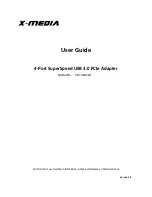
Page 17 of 44
™
2 vLoc3-9800 Receiver
With the maximum signal found and the compass running Forward/Backward, the vLoc3 receiver is now directly over the line
and exactly across it.
If the signal is not distorted, the maximum signal's position will coincide with the position indicated by the arrows. If these two
positions do not agree it may be because there is signal distortion. Treat the results with caution.
Continue to trace the line to its destination or source.
If you have selected the Omni Peak antenna configuration arrows will not appear on either side of the compass. This is because
when in Omni mode the line can be detected from any direction.
Pressing and holding the “f” key will bring up the frequency table in a locate screen.
Power 50
Power 60
Radio
491Hz
512Hz
8.19kHz
8KFF
9.82kHz
32.8kHz
Use the “+” and “-” keys to navigate quickly to the desired frequency. Press the “i” key to select a highlighted choice and return
to the locate screen.
2.12 Searching (sweeping) an Area in the Peak Mode
Buried utilities may be parallel to each other and frequently they cross
the area being searched at various angles and depths.
As the locator antennas response is directional (using the traditional
screen), it is important to search the area in the same or similar pattern
as shown. This orients the antennas in a way that will locate any signals
being radiated from the buried utility.
Once a response is found, trace pinpoint and mark the utility. Searching
an area in this way is generally but not exclusively done in the Peak
mode using passive locating.
2.13 Searching (sweeping) an Area in the Omni Peak Mode
Searching in the Omni Peak mode is similar to the Peak mode, except
it is only necessary to sweep an area in one direction. A zig-zag motion
is enough rather than a full grid action because the locator will respond
to a signal from a line in any direction. It has the benefit of cutting the
sweep time in half.
















































